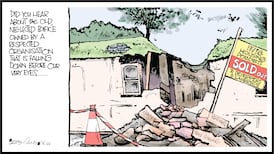Big farms are the only way the massive subsidisation of agriculture can be reduced, writes SARAH CAREY
THE POOR Taoiseach. Its been a bad year and last week he finally had the opportunity to do something cheerful – open a motorway in Ballinasloe – only to have his feel-good moment drowned out by protesting farmers. I felt sorry for the Taoiseach, who probably needed cheering up but I sympathise a lot with farmers too.
Prices for the food they produce are collapsing while subsidies are being slashed. They are lectured about the free market but between globalisation and regulation are forced to work in a deeply distorted one. With banks increasingly tight-fisted, credit is a big issue. There’s nothing abstract about that when you’re told you can’t have any money to buy feed for your cattle.
Worst of all, public debate is chock-a-block with politicians and commentators emoting over the trials of the unemployed, but farmers are the subject of harsh, often vindictive criticism. It’s easy to say they should just give it up, but where are they supposed to go? In other words, I’m on their side.
So it’s with some degree of reluctance that I say the Irish Farmers’ Association and Irish Creamery Milk Suppliers Association should admit that it’s time to throw in the towel. Farming as it is practised in Ireland today is a lossmaking enterprise. The entire structure of agriculture, from the price farmers are paid for their produce and what they pay out in costs, all adds up to a minus. Trinity College professor Alan Matthews has calculated that the only income that farm families had from their farm enterprises last year came from direct payments and these amount to almost €2 billion. Without these payments, farming families would starve. You can see why they’re motivated to protest.
There are many structural problems in Irish agriculture, but one follows on nicely from last week’s column which mentioned the Land Commission. The purpose of the commission was a romantic one – break up big farms into smaller but viable units.
There was just one problem that dogged the commission throughout its existence. What’s viable? In the 1930s, they thought it was 30 acres. In the 1940s that went up to 40 acres and so on until the commission stopped acquiring land in 1983. There are roughly 120,000 farms in the country and 80,000 of those are under 80 acres or 32 hectares. Fifty-five thousand are under 50 acres or 20 hectares. None of these are viable. There are some positive features of small farming and I’ll get to those another day, but the fact is that small farming is killing the business of Irish agriculture. This is the commission’s legacy. Another part of the legacy is the insistence that small farming is a noble pursuit and big farmers are malevolent overlords. Both the myth-making and the fragmentation of land must be reversed. Demonising big farmers is a mistake because big farms are the only way the massive subsidisation of agriculture can be reduced.
If agriculture operated in a free market, the forces would operate in the normal way. Lossmaking farms would sell up and efficient farmers would buy up the land and become productive and profitable. This is happening, but at an impossibly slow rate. The size of the average farm increased by just one hectare between 2000 and 2007. The number of farms dropped by only 10 per cent in those years. Despite the fact that farm incomes are collapsing, the rate at which farmers are leaving the land is too slow. Ask any country auctioneer and he’ll tell you that land hardly ever comes up for sale. Just over half of Irish farmers are over 55 and a young farmer has to wait for one of them to die to get a chance to expand so that he can make a profit.
Why? Subsidies create terrible problems for farming, but one of them is that they reduce the push factor to get people off the land. An elderly couple on 30 acres can eke out an existence on the single payment and the old-age pension, particularly since the break was made between production and payment. They don’t actually have to do anything to get the cheque.
At the other end of the scale, a young farmer who perhaps inherited the few acres from his parents, is able to hang on to the land while supplementing his income from construction. Only half of Irish farmers describe it as their sole source of income. The disappearance of that safety net is just another reason for farmers to find themselves in a state of panic.
We could wait for nature to take its course, but as long as the subsidies are there, the process will be slow – too slow for “professional” farmers who will go under while waiting for things to change. Agriculture has suffered from a proliferation of interference, but I wonder if there is a case for one last intervention.
Whether or not one agrees with what happened in the past, I think we need a 21st century Land Commission. Just as big farmers were compelled to sell their land in the 20th century, should we consider forcing small ones to sell it back? That annual spend of €2 billion would buy a lot of land in just one year that could be redistributed to create efficient farms.
The industry is dying, so isn’t it better to do some triage? Write one last cheque for the fatally wounded and focus on saving the rest.









